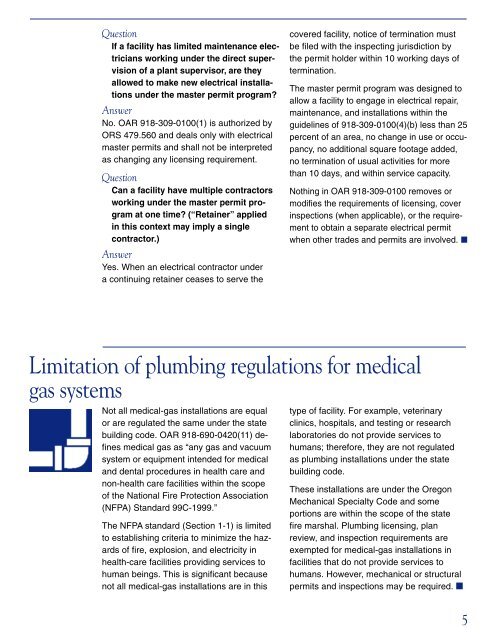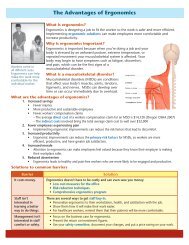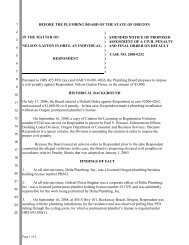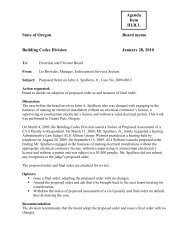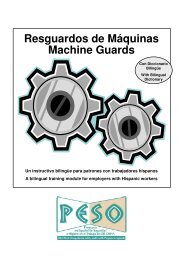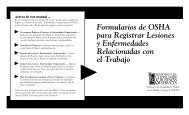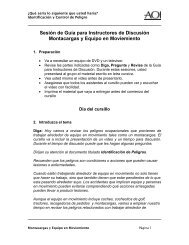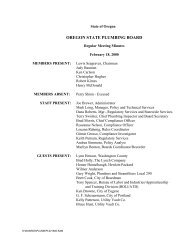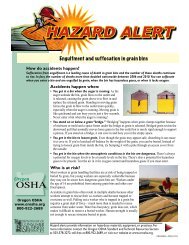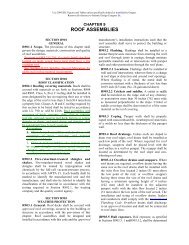Arc-fault circuit interrupter requirements - DCBS Welcome - State of ...
Arc-fault circuit interrupter requirements - DCBS Welcome - State of ...
Arc-fault circuit interrupter requirements - DCBS Welcome - State of ...
Create successful ePaper yourself
Turn your PDF publications into a flip-book with our unique Google optimized e-Paper software.
Question<br />
If a facility has limited maintenance electricians<br />
working under the direct supervision<br />
<strong>of</strong> a plant supervisor, are they<br />
allowed to make new electrical installations<br />
under the master permit program?<br />
Answer<br />
No. OAR 918-309-0100(1) is authorized by<br />
ORS 479.560 and deals only with electrical<br />
master permits and shall not be interpreted<br />
as changing any licensing requirement.<br />
Question<br />
Can a facility have multiple contractors<br />
working under the master permit program<br />
at one time? (“Retainer” applied<br />
in this context may imply a single<br />
contractor.)<br />
Answer<br />
Yes. When an electrical contractor under<br />
a continuing retainer ceases to serve the<br />
covered facility, notice <strong>of</strong> termination must<br />
be filed with the inspecting jurisdiction by<br />
the permit holder within 10 working days <strong>of</strong><br />
termination.<br />
The master permit program was designed to<br />
allow a facility to engage in electrical repair,<br />
maintenance, and installations within the<br />
guidelines <strong>of</strong> 918-309-0100(4)(b) less than 25<br />
percent <strong>of</strong> an area, no change in use or occupancy,<br />
no additional square footage added,<br />
no termination <strong>of</strong> usual activities for more<br />
than 10 days, and within service capacity.<br />
Nothing in OAR 918-309-0100 removes or<br />
modifies the <strong>requirements</strong> <strong>of</strong> licensing, cover<br />
inspections (when applicable), or the requirement<br />
to obtain a separate electrical permit<br />
when other trades and permits are involved. ■<br />
Limitation <strong>of</strong> plumbing regulations for medical<br />
gas systems<br />
Not all medical-gas installations are equal<br />
or are regulated the same under the state<br />
building code. OAR 918-690-0420(11) defines<br />
medical gas as “any gas and vacuum<br />
system or equipment intended for medical<br />
and dental procedures in health care and<br />
non-health care facilities within the scope<br />
<strong>of</strong> the National Fire Protection Association<br />
(NFPA) Standard 99C-1999.”<br />
The NFPA standard (Section 1-1) is limited<br />
to establishing criteria to minimize the hazards<br />
<strong>of</strong> fire, explosion, and electricity in<br />
health-care facilities providing services to<br />
human beings. This is significant because<br />
not all medical-gas installations are in this<br />
type <strong>of</strong> facility. For example, veterinary<br />
clinics, hospitals, and testing or research<br />
laboratories do not provide services to<br />
humans; therefore, they are not regulated<br />
as plumbing installations under the state<br />
building code.<br />
These installations are under the Oregon<br />
Mechanical Specialty Code and some<br />
portions are within the scope <strong>of</strong> the state<br />
fire marshal. Plumbing licensing, plan<br />
review, and inspection <strong>requirements</strong> are<br />
exempted for medical-gas installations in<br />
facilities that do not provide services to<br />
humans. However, mechanical or structural<br />
permits and inspections may be required. ■<br />
5


